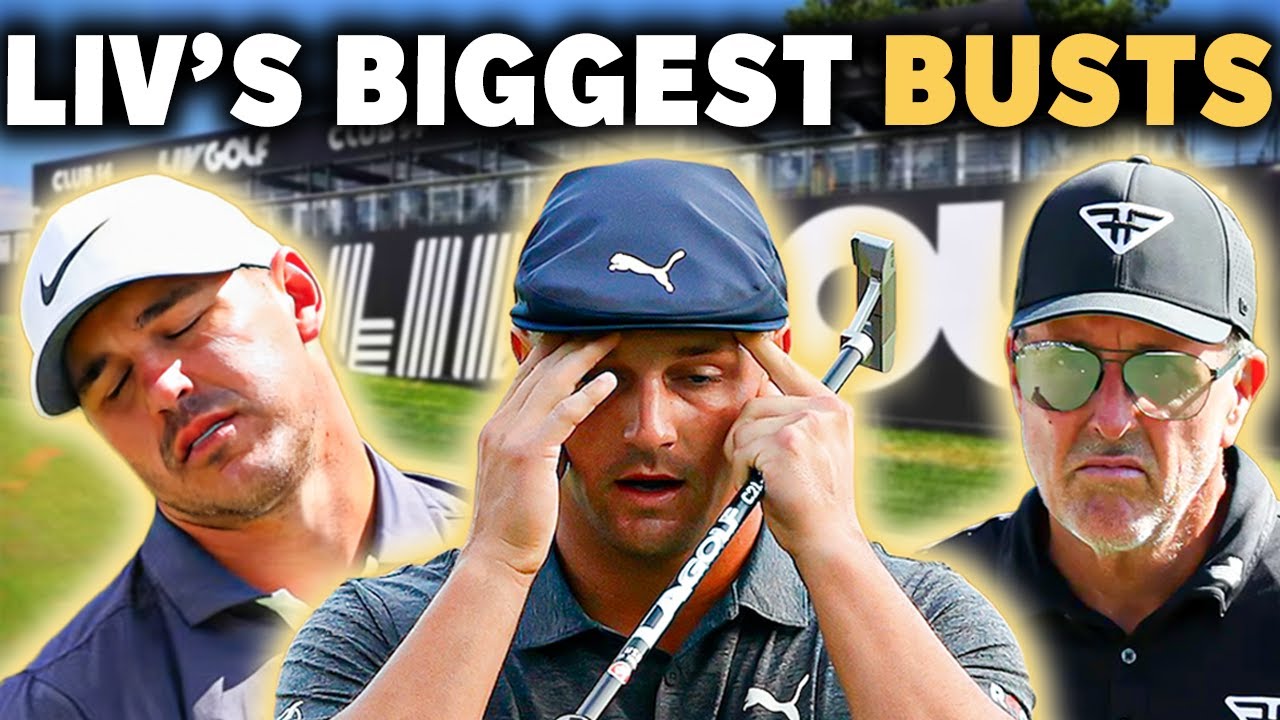💰 LIV Golf threw around billions to lure some of the biggest names in the game… but not everyone lived up to the hype. From Ryder Cup legends to Masters champions, these are the 10 LIV golfers who took the money but flopped on the course.
In this video, we reveal:
⛳ The shocking downfall of Phil Mickelson after his $200M deal
⛳ Sergio García’s fall from Ryder Cup hero to forgotten star
⛳ Why Pat Perez became LIV’s biggest meme
⛳ How Bubba Watson and Henrik Stenson’s careers unraveled
⛳ The embarrassing early struggles of Bryson and Brooks
LIV promised glory, but for many of these golfers, the millions only exposed decline, controversy, and lost legacies.
👉 Do you think these golfers made the right move — or did they sell out their careers? Let us know in the comments!
#LIVGolf #GolfMoney #PGA
What happens when millions of dollars can’t buy greatness? When golf legends trade loyalty for record-breaking contracts, only to find themselves forgotten on leaderboards? Live Golf promised to change the sport forever, offering jaw-dropping sums to players who couldn’t resist the payday. But for some, those deals didn’t bring glory. They exposed decline, fueled controversy, and left fans wondering if they sold their legacy for nothing. From RDER Cup heroes turned irrelevant to Masters champions who cashed in and vanished, these are the 10 Liv golfers who took the money but flopped in spectacular fashion. Graham McDowell was one of Liv’s early signings. And at first it looked like a decent pickup. A former US Open champion with Rder Cup pedigree, he came in with a reported deal worth around 10 to 15 million. But the problem, by the time he joined, his best golf was already a decade behind him. Instead of revitalizing his career, Liv’s only highlighted how far he had fallen. McDow routinely finished near the bottom of leaderboards, rarely threatening to contend. And if fans remember anything about him in Leviv, it’s not his golf, it’s his awkward press conference, that infamous moment where he tried defending Liv’s ties to controversy and fumbled his words so badly he later admitted he regretted it. For many, McDow became a symbol of Liv’s biggest criticism, paying huge sums to players who were simply past their prime. And as we’ll see, he wasn’t the only one. Charles Schwarzel was supposed to be one of Liv’s early success stories. After all, the 2011 Masters Champion came out swinging, literally, by winning the very first Liv event in London. That victory alone earned him a massive $4 million paycheck, the largest single prize in golf at the time. But here’s the catch. That was the peak. After that, Schwarzel disappeared from the spotlight. Tournament after tournament, his results slid with finishes so far down the leaderboard that fans joked he retired after one win. Critics saw him as the perfect example of Liv’s flaw. A player who cashed in on one big moment, then quietly collected checks while the competition and relevance faded away. A one-hit wonder on a tour that promised greatness. And yet, his story wasn’t nearly as frustrating as the next name on this list. Few names carry as much Ryder Cup fire as Ian Palter. For years, he was Europe’s emotional spark, a man who thrived under pressure. That’s why his move to live felt shocking at first. A Ryder Cup legend walking away for a rumored 20 to30 million deal. But once the dust settled, Poulter’s impact on Liv was, well, underwhelming. His results were flat. His rankings slipped. And before long, he wasn’t even qualifying for majors. Instead of leading Liv as a top competitor, he became more of a marketing face, showing up in flashy outfits, giving interviews, but never really contending. For fans, it felt like Palter traded Rder Cup glory for irrelevance. And as one critic put it, Liv didn’t sign Ian Palter the competitor, they signed Ian Palter, the personality. Unfortunately, personality alone doesn’t win trophies. And that becomes even clearer with the next name, who sacrificed more than anyone for his live payday. Henrik Stenson’s move to live was more than just controversial. It was careering. At the time, he wasn’t just another bigname signing. He was Europe’s Rder Cup captain. A role built on honor, tradition, and leadership. The moment Stenson signed with Liv, he was stripped of that captaincy. Fans saw it as one of the biggest betrayals in Ryder Cup history. And while he made headlines by winning his very first live event, it quickly went downhill from there. Injuries piled up. His consistency vanished and the excitement of his debut victory turned into silence as his name faded from leaderboards. One journalist even called it the most expensive oneweek cameo in golf history. Stenson went from respected leader to forgotten figure. Proof that sometimes the cost of a contract isn’t measured in dollars, but in legacy. And if you think that sounds brutal, wait until you hear what happened to this two-time Mast’s champion. When Liv signed Bubba Watson, it looked like a massive win. A two-time Masters champion, fan favorite, and one of the most creative shot shapers in golf. Bubba brought star power. Rumor has it his deal was worth around $50 million. But there was a problem. By the time Bubba teed it up for Liv, his body was already breaking down. Injuries kept him from competing at full strength. And when he did play, the results were forgettable. Instead of leading his team on the course, Bubba seemed more focused on the business side, running his franchise, doing appearances, and acting more like an owner than a player. For fans, it felt like Liv bought a highlight reel from the past, not a contender for the future. And while Bubba’s legacy at Augusta is secure, his Liv career left many wondering if he’d already quietly retired, only with a paycheck attached. But if Bubba looked semi-retired, this next live star became the face of underachievement. and the butt of endless jokes. Pat Perez might be the most infamous example of a golfer who took the live money and did absolutely nothing with it. Reportedly pocketing around $10 million, Perez wasn’t signed for major wins or world rankings. He was signed for attitude. Loud, outspoken, and always ready with a headline. Perez quickly became one of Liv’s most vocal defenders. The problem, his golf backed it up. Week after week, he found himself at the bottom of leaderboards. sometimes finishing dead last while still cashing massive checks. Fans mocked him as the guy who hit the jackpot by showing up, not showing out. And yet, Perez leaned into it, trash-talking the PGA Tour, defending Liv at every turn and becoming more of a meme than a competitor. For critics, he embodied the worst stereotype of Liv. Big paydays for players who stopped competing the moment the ink dried. But if Perez was a meme, the next golfer was supposed to be a legend. Instead, he became Liv’s biggest disappointment of all. Phil Mickelson wasn’t just another Liv signing. He was the Liv signing. Reportedly paid around $200 million. Lefty became the face of the new league. The headline name meant to legitimize the entire project. But instead of dominating the competition, Phil’s game collapsed. Since joining Liv, Mickelson has struggled mightily. His finishes have been dismal with more rounds over par than under. And while he still pops up on leaderboards at the occasional major on Liv, he’s been a shadow of the player who once thrilled fans with daring shots and dramatic victories. Worse yet, Phil’s off-the-course headlines have completely overshadowed his play. From lawsuits to awkward interviews to late night Twitter rants, he’s become more of a lightning rod for controversy than a contender. For Liv, the $200 million gamble was supposed to buy glory. Instead, it bought them a legend whose best golf was already gone. And as bad as that sounds, the next name proved that even younger stars with massive deals weren’t immune to early embarrassment. When Bryson Dashambo signed with Liv, the deal was jaw-dropping. A reported $125 million to bring over one of the most polarizing figures in golf. Fans expected fireworks, monster drives, datadriven dominance, and Bryson’s larger than-l life personality taking center stage. But the reality, his first stretch with Liv was anything but spectacular. Injuries nagged at him. His game looked completely out of sync, and he struggled to keep pace with expectations. Instead of being Liv’s scientific superstar, he was mocked as an overpaid experiment, more lab coat than leaderboard. Rumors swirled about his unhappiness, his swing changes, and whether he’d lost the competitive edge that once made him a US Open champion. For a while, it seemed like Liv had shelled out nine figures for a golfer who couldn’t deliver. And as disappointing as Bryson’s early struggles were, the next player might have been even more frustrating. A five-time major champion whose body and attitude seemed to betray him the moment he cashed in. When Brooks kept signed with Liv for a reported $100 million plus, it felt like a seismic shift, a four-time major champion in his prime. This was supposed to be proof that Liv could lure true elite talent. But instead of domination, Kepka stumbled out of the gate. Plagued by knee injuries and questions about his motivation, Brooks looked disinterested in those early live events. His scores were mediocre, his body language flat, and his once icy confidence seemed to vanish. He even admitted in interviews that he wasn’t sure he could compete at the highest level anymore. For critics, it was proof that Liv had bought a name, not a fighter. Fans accused him of taking the bag and losing his edge, a major champion turned paycheck collector. And while Kepka eventually silenced doubters with a stunning comeback at the majors, those early months painted a very different picture. A superstar who looked like he’d already given up. But if Brooks’s flop was shocking, the final name on this list was perhaps the most painful of all. A Riter Cup icon who went from beloved to forgotten almost overnight. Sergio Garcia’s move to live might go down as one of the most disappointing chapters in modern golf. Once a Rder Cup hero and Mast’s champion, Sergio reportedly pocketed $40 to $50 million for joining the Breakaway Tour. Fans expected fireworks. Instead, they got frustration. Almost immediately, his results fell flat. Week after week, Sergio failed to contend, finishing deep in the field and showing none of the spark that once made him one of golf’s most electric players. Worse, his attitude soured. At one point, he threatened to quit the sport altogether after fines and backlash piled up, leaving many wondering if he even wanted to play anymore. The Ryder Cup, where Sergio had built his legend, turned its back on him. Suddenly, the fiery Spaniard who once carried Europe was irrelevant, remembered less for clutch putts and more for walking away when the spotlight dimmed. For many fans, Sergio became the symbol of what live critics feared most. a star who chased the money, lost the respect, and gave up the legacy that had once defined him. At the end of the day, Live Golf was built on massive contracts and promises of glory. But as these names prove, money can’t buy passion, consistency, or legacy. Graham McDowell, Ian Palter, Sergio Garcia, all once Ryder Cup heroes faded into the background. Charles Schwarzel and Henrik Stenson had brief sparks before vanishing. Bubba Watson and Pat Perez became punchlines. Even legends like Phil Mickelson, Bryson Dashambo, and Brooks Kepka stumbled badly in their early Liv years. The irony: Liv set out to redefine golf’s future. But in many cases, it only reminded fans how quickly the past can fade. Contracts worth tens or even hundreds of millions couldn’t guarantee success. And for some of these players, their names may be remembered less for their victories and more for how their careers fizzled after chasing the payday. So the question remains, was it worth it? For the players, maybe for their legacies, that’s a much tougher call. Which one do you think was the biggest letdown? Let us know in the comments below. [Music]








19 Comments
At the outset, maybe, LIV Golf needed the draw of the profile names mentioned in this piece.
LIV Golf, now, has some of the best current, players in golf. Players who excelled at the Ryder Cup, such as John Rahm, Tyrrel Hatton and Bryson.
In addition, LIV has some of todays outstanding emergent players such as David Puig, Tom McKibben and Joaquin Niemann.
None of them let me down, I did not get anything from their career or fame, still had to pay my way and play my game, so I hope that they are happy with their direction and future….
When prostitutes take your money, at least you get something for your $.
Once the mule gets the carrot, he stops walking. Can’t blame them for taking the money…heck, that’s one of the major reasons you would want to play professional sports. But, they really don’t have a reason to want to win one of those events…it’s not like the PGA Tour where it means more than money.
These players always say they never play for the money…..yeah right.
Even if they stay with PGA they may not flourish as age is a factor. Now they have money LIV gave them and they can move on happily. They made their choices and they are right. Legacy does not pay.
Start a league that has 10 plus handicaps only players . I bet the 99.9 percent of us would watch
You clearly don't understand golf. LIV golfers are the top golfers in the world. The PGA and especially the DP world tour are now 2nd class. LIV are much more entertaining and enjoyable to watch.
The performance of these players is not as bad as you make it.
PGA tour has only a handful of top players left.
The money removed the best event in golf in america (liv or die) no petty for all of them
LIV is the welfare of golf. You can play terrible and still get paid well. PGA miss the cut you lose money so you try and get better. Will never watch LIV.
Nobody other than the players family and caddie give a crap when they win one of these exhibitions.
You can't play 3 days and expect to dial it in when you have to play 4.
Problem #1, golf fans do not need another tour to watch. There already is the PGA tour, Champions and the LPGA. And between all of them the ratings aren't that great. Problem #2, I don't know anyone that watches LIV, it's pretty much an exhibition tour for has-been's and basically speaking, that's what the champions tour is for. LIV will survive as long as the Saudi's keep pouring money into it. Once they stop, "poof" LIV will disappear…
The purse they get for winning an event has already been advanced in their signing bonus. Phil got $200 million to sign, but he will have to win that much before he actually receives any more money. If you’ve already been paid to win, there’s not much incentive to actually win later. Phil and Brooks needed the money, Phil for his gambling, Brooks for his health. Rahm gave the lamest reason, given that he was already wealthy from playing PGA golf.
Sold your soul to the devil, now you to come back to the PGA , you took the money see you later enjoy your dirty money
Why is Dustin Johnson not on the list?
Best time to take the pay out is when you are past your prime.
Cam smith was on top of the world, mid pack who cares I am paid at LIV. Poulter etc, were losing their PGA card
Cameron smith